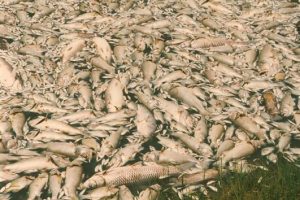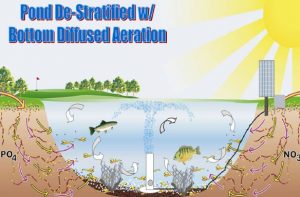Pond Turnover can happen any time of year, and can be deadly to fish populations.
Here’s how it works: have you ever jumped in a lake during the summer and felt that cold water on your feet? What you are feeling is the sharp temperature difference caused by lake stratification. Stratification is a natural process that happens annually in most ponds and lakes in North Texas. Stratification has many side effects which are part of the dynamics and overall health of your pond.
As weather changes, so do temperatures in your lake or pond.
During the summer, lakes and deeper ponds will stratify into different layers due to differences in water temperature. The sunlight heated water near the surface is less dense than the cooler water beneath it. This difference in density does not allow these two layers to mix. This results in decreasing temperatures moving from the lake surface to the bottom substrate. The point of greatest temperature drop is called the “thermocline” and marks the transition from warm, oxygen rich water to cooler, anaerobic water (lacking oxygen).

Fish kill due to oxygen depletion from turnover
In a stratified pond, the water close to the pond bottom and the associated sediment layer is devoid of oxygen and can only support anaerobic bacteria. These bacteria are inefficient at breaking down the organic material that settles to the pond bottom (leaves, grass, algae, aquatic vegetation, etc.). As a result, a thick layer of decaying “muck” accumulates over time. High levels of methane and sulfur gases concentrate in this layer. Due to poor water quality, fish are not able to use the area below the thermocline for extended periods of time.
Cooler weather means your lake or pond will soon turn over.
As the surface water begins to cool in the fall, it eventually equalizes in temperature with the deeper water. When this happens the entire water column will mix or “turnover”. As a result, the bottom sediments are stirred and anaerobic conditions are mixed throughout the entire pond for a period of time. As this happens, it releases mass quantities of sulfur and methane gases into the atmosphere. Therefore, it is common for urban ponds to emit very strong, septic odors during mid to late fall. These bad odors are most noticeable on days with little or no wind.
Smaller ponds can turnover from smaller events, but with big effects.
In small urban ponds, turnovers are not restricted to the fall season. A brief, heavy thunderstorm during the summer is often the only catalyst needed to turn over retention ponds in this area. These types of turnovers are usually the most damaging to the health of a pond. In some cases, a pond turnover can happen so quickly that it will kill fish due to a severe drop in dissolved oxygen levels. The biological oxygen demand (BOD) of the pond is the determining factor in the consequences of a rapid turnover. Ponds with large fish populations, deep organic sediment layers, high nutrients, and poor aeration are most prone to catastrophic fish kills.

Pond Turnover can be prevented through use of diffused aeration
Diffused aeration can prevent pond turnover. Surface fountains will not.
Stratification and pond turnover are normal in this region and will occur every year. The only way to prevent turnover is to eliminate stratification and keep the pond thoroughly mixed all year long. This can be accomplished by installing a bottom diffused aeration system. The bottom aeration will prevent anaerobic conditions from establishing at the pond bottom. This allows beneficial aerobic bacteria (oxygen loving) to flourish. Aerobic bacteria are very efficient at breaking down organic matter and converting it to benign byproducts with no associated odors.
IMPORTANT! Bottom diffused aeration systems should be installed and operational prior to May 1st here in north Texas. Turning on an aeration system after a pond has already stratified will cause the pond to rapidly turnover and lead to catastrophic fish kills.
It should be noted that decorative surface fountains DO NOT prevent stratification nor pond turnover in deeper ponds. Call Magnolia Fisheries if you are interested in preventing or minimizing pond turnover in your pond or lake.
